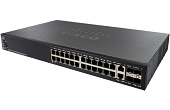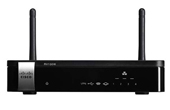24-Port 10/100Mbps PoE Switch Cisco SF300-24P (SRW224G4P-K9)

24-Port 10/100Mbps PoE Managed Switch CISCO SF300-24P (SRW224G4P-K9)
- Product ID Number: SRW224G4P-K9
- 24 port 10/100Mbps PoE ; 2 port 10/100/1000Mbps; 2 Combo mini-GBIC ports.
- Performance: Switching capacity 12.8 Gbps, nonblocking, Forwarding rate 9.52 mpps wire-speed performance.
- Layer 2: Port grouping up to 8 ports per group with 16 candidate ports for each (dynamic) 802.3ad link aggregation, Number of VLANs 256 active VLANs (4096 range), Head-of-line (HOL) blocking HOL blocking prevention.
- Layer 3: IPv4 routing Wirespeed routing of IPv4 packets, Up to 32 static routes and up to 32 IP interfaces, Classless Inter-Domain Routing (CIDR) support for CIDR.
- QoS: Priority levels 4 : hardware queues, Scheduling: Priority queuing and weighted round-robin (WRR), Queue assignment based on DSCP and class of service (802.1p/CoS).
|
Performance |
|
|
Ports |
24x RJ-45 Fast Ethernet |
|
2x RJ-45 Gigabit Ethernet |
|
|
2x RJ-45 + SFP Gigabit Ethernet Combo Ports |
|
|
PoE |
24x RJ-45 Fast Ethernet Power Dedicated: 180W |
|
Speed |
Switching Capacity in Gigabits per Second (Gbps): 12.8 |
|
Capacity in Millions of Packets per Second (mpps) with each packet being 64-bytes: 9.52 |
|
|
MAC Address Table Size |
Up to 8000 MAC addresses |
|
Frame Sizes |
Jumbo Frames: up to 10 KB supported on 10/100 and Gigabit interfaces |
|
Switching Method |
Managed |
|
Layer 2 Switching |
Spanning Tree Protocol (STP): |
|
Standard 802.1d Spanning Tree support |
|
|
Fast convergence using 802.1w (Rapid Spanning Tree [RSTP]), enabled by default |
|
|
Multiple Spanning Tree instances using 802.1s (MSTP) |
|
|
Port grouping: |
|
|
Support for IEEE 802.3ad Link Aggregation Control Protocol (LACP) |
|
|
Up to 8 groups |
|
|
Up to 8 ports per group with 16 candidate ports for each (dynamic) 802.3ad link aggregation |
|
|
VLAN: |
|
|
Support for up to 256 VLANs simultaneously (out of 4096 VLAN IDs) |
|
|
Port-based and 802.1Q tag-based VLANs |
|
|
MAC-based VLAN |
|
|
Management VLAN |
|
|
Private VLAN Edge (PVE), also known as protected ports, with multiple uplinks |
|
|
Guest VLAN |
|
|
Unauthenticated VLAN |
|
|
Voice Lan: |
|
|
Voice traffic is automatically assigned to a voice-specific VLAN and treated with appropriate levels of QoS |
|
|
Generic VLAN Registration Protocol (GVRP)/Generic Attribute Registration Protocol (GARP): |
|
|
Protocols for automatically propagating and configuring VLANs in a bridged domain |
|
|
Dynamic Host Configuration Protocol (DHCP) Relay at Layer 2: |
|
|
Relay of DHCP traffic to DHCP server in different VLAN. Works with DHCP Option 82 |
|
|
Internet Group Management Protocol (IGMP) versions 1, 2, and 3 snooping: |
|
|
IGMP limits bandwidth-intensive multicast traffic to only the requesters; supports 256 multicast groups (source-specific multicasting is also supported) |
|
|
IGMP Querier |
|
|
IGMP querier is used to support a Layer 2 multicast domain of snooping switches in the absence of a multicast router |
|
|
Head-of-line (HOL) blocking: |
|
|
HOL blocking prevention |
|
|
Layer 3 |
IPv4 Routing: |
|
Wirespeed routing of IPv4 packets |
|
|
Up to 32 static routes and up to 32 IP interfaces |
|
|
Classless Inter-Domain Routing (CIDR): |
|
|
Support for CIDR |
|
|
DHCP relay at Layer 3: |
|
|
Relay of DHCP traffic across IP domains |
|
|
User Datagram Protocol (UDP) relay: |
|
|
Relay of broadcast information across Layer 3 domains for application discovery or relaying of BootP/DHCP packets |
|
|
Security |
Secure Shell Protocol (SSH): |
|
SSH secures Telnet traffic to and from the switch; SSH v1 and v2 are supported |
|
|
Secure Sockets Layer (SSL): |
|
|
SSL support: Encrypts all HTTPS traffic, allowing highly secure access to the browser-based management GUI in the switch |
|
|
IEEE 802.1X (Authenticator role): |
|
|
802.1X: RADIUS authentication and accounting, MD5 hash; guest VLAN; unauthenticated VLAN, single/multiple host mode and single/multiple sessions |
|
|
Supports time-based 802.1X |
|
|
Dynamic VLAN assignment |
|
|
Layer 3 isolation: |
|
|
Allow / disallow routing between IP subnets or directly connected IP networks |
|
|
Layer 2 isolation Private VLAN Edge (PVE) with community VLAN: |
|
|
PVE (also known as protected ports) provides Layer 2 isolation between devices in the same VLAN, supports multiple uplinks |
|
|
|
|
|
Port security: |
|
|
Locks MAC addresses to ports, and limits the number of learned MAC addresses |
|
|
RADIUS/TACACS+: |
|
|
Supports RADIUS and TACACS authentication. Switch functions as a client |
|
|
Storm control: |
|
|
Broadcast, multicast, and unknown unicast |
|
|
DoS prevention: |
|
|
DoS attack prevention |
|
|
Congestion avoidance: |
|
|
A TCP congestion avoidance algorithm is required to minimize and prevent global TCP loss synchronization |
|
|
ACLs: |
|
|
Support for up to 512 rules |
|
|
Drop or rate limit based on source and destination MAC, VLAN ID or IP address, protocol, port, differentiated services code point (DSCP)/IP precedence, TCP/ UDP source and destination ports, 802.1p priority, Ethernet type, Internet Control Message Protocol (ICMP) packets, IGMP packets, TCP flag |
|
|
Quality of Service |
Priority Levels: 4 hardware queues |
|
Scheduling: |
|
|
Strict priority and weighted round-robin (WRR) |
|
|
Queue assignment based on DSCP and class of service (802.1p/CoS) |
|
|
Class of Service: |
|
|
Port based; 802.1p VLAN priority based; IPv4/v6 IP precedence/type of service (ToS)/DSCP based; Differentiated Services (DiffServ); classification and re-marking ACLs, trusted QoS |
|
|
Rate Limiting: |
|
|
Ingress policer; egress shaping and rate control; per VLAN, per port, and flow based |
|
|
IPv6 |
IPv6: |
|
IPv6 host mode |
|
|
IPv6 over Etheret |
|
|
Dual IPv6/IPv4 stack |
|
|
IPv6 neighbor and router discovery (ND) |
|
|
IPv6 stateless address auto-configuration |
|
|
Path maximum transmission unit (MTU) discovery |
|
|
Duplicate address detection (DAD) |
|
|
ICMP version 6 |
|
|
IPv6 over IPv4 network with Intra-Site Automatic Tunnel Addressing Protocol(ISATAP) support |
|
|
IPv6 QoS |
|
|
Prioritize IPv6 packets in hardware |
|
|
IPv6 ACL |
|
|
Drop or rate limit IPv6 packets in hardware |
|
|
Multicast Listener Discovery (MLD) snooping |
|
|
Deliver IPv6 multicast packets only to the required receivers |
|
|
IPv6 applications |
|
|
Web/SSL, Telnet server/SSH, ping, traceroute, Simple Network Time Protocol (SNTP), Trivial File Transfer Protocol (TFTP), SNMP, RADIUS, syslog, DNS client, protocol-based VLANs |
|
|
IPv6 RFCs supported |
|
|
Cable |
Unshielded twisted pair (UTP) Category 5 or better for 10BASE-T/100BASE-TX; UTP Category 5 Ethernet or better for 1000 BASE-T |
|
Buttons |
Reset button |
|
LED |
System, Link/Act, PoE, Speed |
|
Memory |
CPU: 128 MB |
|
Flash: 16 MB |
|
|
Buffer |
Packet Buffer: 4 Mb |
|
Management |
Web user interface: |
|
Built-in switch configuration utility for easy browser-based device configuration (HTTP/HTTPS). Supports configuration, system dashboard, system maintenance, and monitoring |
|
|
Remote Monitoring (RMON): |
|
|
Embedded RMON software agent supports 4 RMON groups (history, statistics, alarms, and events) for enhanced traffic management, monitoring, and analysis |
|
|
IPv4 and IPv6 dual stack: |
|
|
Coexistence of both protocol stacks to ease migration |
|
|
Port mirroring: |
|
|
Traffic on a port can be mirrored to another port for analysis with a network analyzer or RMON probe. Up to 8 source ports can be mirrored to one destination port. A single session is supported |
|
|
VLAN mirroring: |
|
|
Traffic from a VLAN can be mirrored to a port for analysis with a network analyzer or RMON probe. Up to 8 source VLANs can be mirrored to one destination port. A single session is supported |
|
|
Fan |
2 pcs |
|
Acoustic Noise |
41.0 dB |
|
MTBF |
241995.9 hours |
|
Certification |
UL (UL 60950), CSA (CSA 22.2), CE mark, FCC Part 15 (CFR 47) Class A |
|
General |
|
|
Form Factor |
1U |
|
Power Requirements |
100-240V 47-63 Hz, internal, universal |
|
Power Consumption |
At most: |
|
110V = 219.9W |
|
|
220V = 213.8W |
|
|
Dimensions (WxHxD) |
17.3 x 1.45 x 13.78' / 44 x 4.44 x 25.7 cm |
|
Weight |
8.22 lb / 3.73 kg |
- Bảo hành chính hãng: 12 tháng.

| Tel: | (028) 7300 1535 |
| Showroom: | 92K Nguyễn Thái Sơn - Phường 3 - Q.Gò Vấp - Tp.HCM |
| Website: | www.sieuthivienthong.com |
| Email: | info@sieuthivienthong.com |


 92K Nguyễn Thái Sơn - Phường 3 - Q.Gò Vấp - Tp.HCM
92K Nguyễn Thái Sơn - Phường 3 - Q.Gò Vấp - Tp.HCM  info@sieuthivienthong.com
info@sieuthivienthong.com (028) 7300 1535
(028) 7300 1535


























